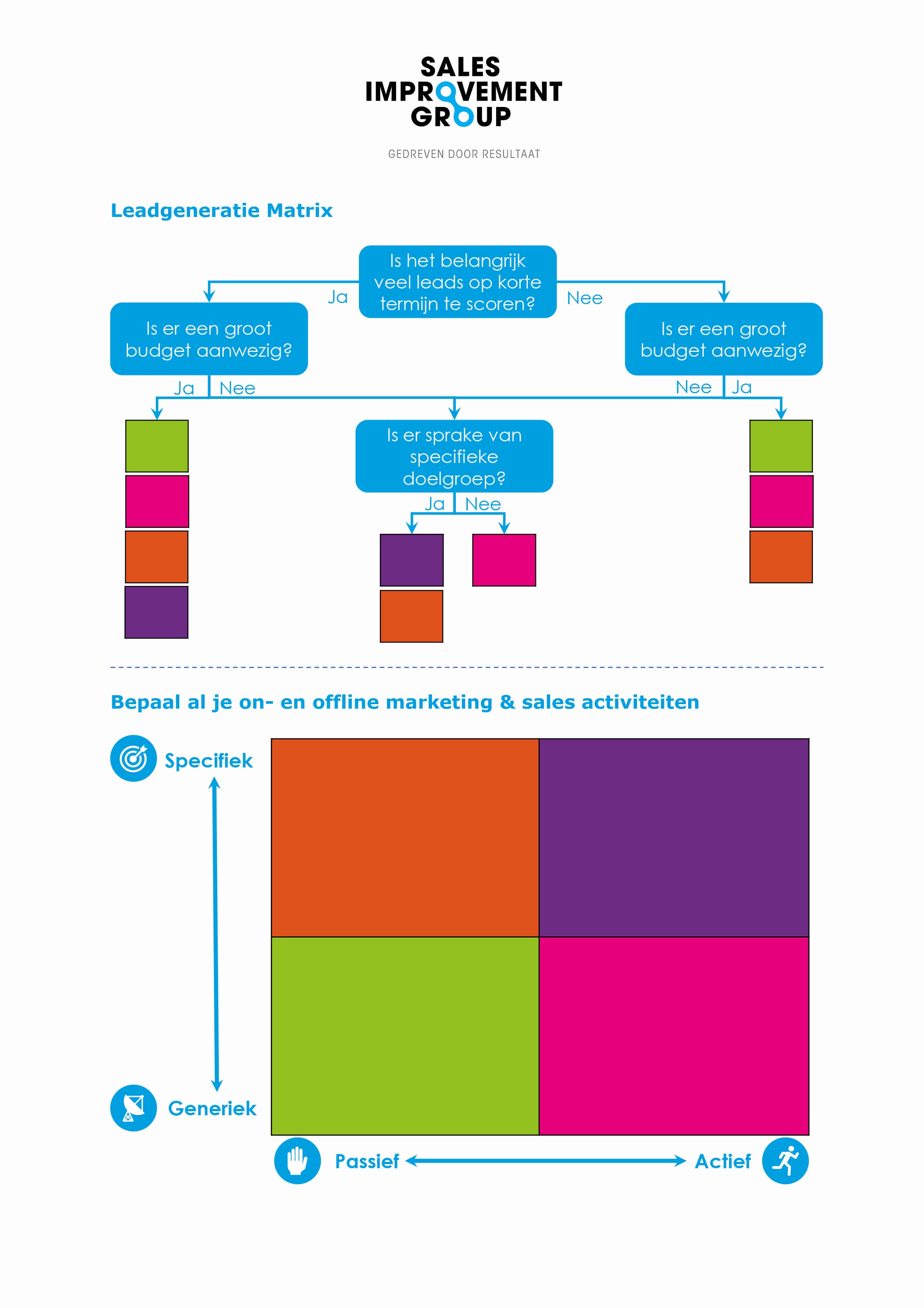Successful Lead Generation: Generate B2B Leads


Last update on: 1 Sept 2025
Reviewed by: ![]() Michel van Hesse
Michel van Hesse
Lead generation is, as the word suggests, the process of generating leads for your company. There is no single uniform definition of the word, but you can interpret it as: 'All marketing activities aimed at attracting new customers.' Lead generation includes a wide range of activities, all of which are aimed at turning unknown individuals or companies into valuable customers. Lead generation is crucial for every business, but especially for B2B companies, it is indispensable.
Contents:

In the business-to-business market, building a strong and long-lasting relationship with customers is more important than in the B2C market. Additionally, in B2B, you deal with a more complicated buyer journey. In many cases, it's not just one person responsible for the decision; multiple individuals from various departments are involved. That makes effective lead generation even more critical in this market.
Lead generation is about identifying and attracting potential valuable customers. You want to connect with such a potential customer, but you also need to nurture this lead until they are ready to make a purchase. Lead generation involves more than just attracting a lead; it can be done in many different ways. The emphasis is increasingly on online activities, but offline lead generation is still viable. Of course, it's also possible to combine multiple activities to achieve the best results.
Whether lead generation is a sales or marketing activity varies by company. Many companies place lead generation under their marketing department. Activities like creating SEO content, making advertisements, and sending out newsletters fall under the responsibility of marketers. However, there are also sales activities, such as cold calling, that are part of lead generation. There is no clear line separating whether lead generation belongs to the marketing or sales department.
A potential customer goes through various stages before becoming a real customer. It often starts as a non-qualified lead (NQL), then becomes a Marketing Qualified Lead (MQL). An MQL shows interest in the product or service but is not yet ready to make a purchase. With an MQL, you engage in lead nurturing until they become a Sales Qualified Lead (SQL). Then, the SQL is converted into an SQO (Sales Qualified Opportunity), with the goal of turning them into a customer.
Would you like to attract more leads as well? We've gathered some useful tips for you. These tips will help your organization attract more valuable leads, and therefore, more valuable customers.
As many customers, as many preferences. Not all your customers are the same, and therefore, not all of them will come to you in the same way. One customer may respond well to reading newsletters, while another prefers a personal conversation. Therefore, don't focus your lead generation on just one approach; ensure a mix of different activities. Lead generation can take place both online and offline. Although the focus is increasingly on online methods, an offline approach may work better for some leads. So, don't dismiss old methods outright.
Lead generation can be time-consuming. That's not a problem, but you shouldn't make it harder than it needs to be. Therefore, use marketing automation. With marketing automation, you collect email addresses from leads and use the obtained data to send targeted messages. Setting up good marketing automation requires an investment, but you'll surely see the returns later on.
It's nice that a part of your lead generation can happen automatically. However, that doesn't mean you should hand over everything. Personal contact is still crucial if you want to build a valuable relationship with a customer. A (telephone) introduction can be just what convinces the lead. Also, having a live chat on your website is a good idea. This way, a lead can easily get in touch if something is not entirely clear.
A significant portion of your leads will have their first encounter with the company on the website. A good website is, therefore, of tremendous importance for lead generation. Ensure a pleasant design that responds quickly and flawlessly. The website should be user-friendly, and leads should be able to contact you easily. Unknown visitors should have the opportunity to leave their email addresses. Only when your website is solid, will many of the other lead generation activities yield results.
Attracting more leads doesn't necessarily mean you'll get more customers. To achieve this, you need to attract leads that are a good fit for your company. Creating a buyer persona can help with this. The buyer persona is a description of your ideal customer. You put yourself in the shoes of your ideal customer, understanding their needs, pain points, and ambitions. This gives you insight into what this customer needs and how you can provide it. This way, you'll better understand how to attract these leads and convert them into valuable customers.
Valuable content on your website serves a dual purpose. On one hand, it makes you more discoverable, attracting more leads. On the other hand, high-quality content helps leads get to know the company better and makes them more inclined to get in touch. Don't be afraid to share some knowledge.
Word-of-mouth advertising is valuable. Therefore, it's nice if you can use your current customers as brand ambassadors. There's a good chance that if they bring in a lead, it will be a valuable one. So, establish a good relationship with your customers and see if you can use them as ambassadors. Having them write reviews for your website is also very useful and can help with lead generation.
Lead generation is something that requires close collaboration between the marketing and sales departments. Because the boundary is not always clear, it's important to establish clear agreements regarding the use of the marketing and sales funnel. When does a lead fall under the responsibility of the marketing department, and when is it handed over to the sales department? By making clear agreements, you can work together toward a good result and more customers.
Lead generation can happen both online and offline. The focus is increasingly on online lead generation, but offline lead generation is still valuable. Online lead generation primarily involves attracting unknown website visitors. On the website, these visitors can then be converted into leads and hot leads.

Attracting website visitors can be done in various ways. Think, for example, of using Google Ads, search engine optimization (SEO), but also social media can be an important channel. On social media, you can advertise and share valuable content. It's crucial in such activities to know where your ideal target audience is located. If you know this, you can focus your actions on it effectively.
Online lead generation can occur both as inbound marketing and outbound marketing. Inbound marketing means that leads come to you. This involves writing blogs, using SEO, and creating attention. The focus in such actions is on the customer. Outbound marketing includes cold acquisition and cold emails. These are often activities that potential customers are less or not at all interested in.
Offline lead generation can be done through phone conversations, as well as at events and trade shows, for example. Networking is still an important form of lead generation. Although this activity is increasingly taking place online, offline events are still valuable. With offline lead generation, customers often feel personally addressed, making them more inclined to grant you the sale.
For many companies, lead generation consists of both online and offline activities. Finding a good balance that fits the target audience and the market is crucial. The exact distribution varies from company to company and industry.
Lead generation is important for both B2C and B2B. In B2B, the buyer's journey is often more complex, resulting in a longer process from suspect to actual customer. Good lead generation and lead nurturing are, therefore, crucial here. In B2C, the buying process is often simpler. However, in the case of expensive purchases, lead generation is also very useful in B2C. In such cases, a consumer often needs more convincing to make a purchase.
Although the precise implementation of lead generation for B2C will differ from B2B, it is largely the same. In B2C as well, suspects need to be attracted and slowly guided through the marketing and sales funnel to eventually become a valuable customer.
Check out the lead generation matrix

If you could use some help with lead generation, feel free to contact us. We're happy to assist you with all the steps of lead generation. We can help you set up a solid marketing and sales funnel and provide you with more information about acquisition. You can turn to us with all your sales-related questions. Is your organization ready for more and better leads? We're here to help!